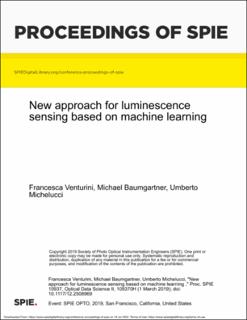Please use this identifier to cite or link to this item:
https://doi.org/10.21256/zhaw-16088| Publication type: | Conference paper |
| Type of review: | Peer review (publication) |
| Title: | New approach for luminescence sensing based on machine learning |
| Authors: | Venturini, Francesca Baumgartner, Michael Michelucci, Umberto |
| DOI: | 10.1117/12.2508969 10.21256/zhaw-16088 |
| Proceedings: | Proceedings Volume 10937 : Optical Data Science II |
| Editors of the parent work: | Jalali, Bahram Kitayama, Ken-ichi |
| Issue: | 109370H |
| Conference details: | SPIE OPTO, San Francisco, USA, 2-7 February 2019 |
| Issue Date: | 2019 |
| Publisher / Ed. Institution: | SPIE |
| Language: | English |
| Subjects: | Artifcial intelligence; Neural network; Machine learning; Oxygen sensor; Luminescence; Optical sensor; Luminescence quenching |
| Subject (DDC): | 006: Special computer methods |
| Abstract: | Luminescence sensors are based on the determination of emitted intensity or decay time when a luminophore is in contact with its environment. Changes of the environment, like temperature or analyte concentration cause a change in the intensity and decay rate of the emission. Typically, since the absolute values of the measured quantities depend on the specific sensing element and scheme used, a sensor needs an analytical model to describe the dependence of the quantity to be determined, for example the oxygen concentration, from sensed quantity, for example the decay time. Additionally, since the details of this dependence are device specific, a sensor needs to be calibrated at known reference conditions. This work explores an entirely new artificial intelligence approach and demonstrates the feasibility of oxygen sensing through machine learning. The new developed neural network is used for optical oxygen sensing based on luminescence quenching. After training the neural network on synthetic data, it was tested on measured data to verify the prediction of the model. The results show a mean deviation of the predicted from the measured concentration of 0.5% air, which is comparable to many commercial and low-cost sensors. The accuracy of the model predictions is limited by the ability of the generated data to describe the measured data, opening up future possibilities for significant improvement by performing the training on experimental data. In this work the approach is tested at different temperatures, showing its applicability in the entire range relevant for biological applications. This work demonstrates the applicability of this new approach based on machine learning for the development of a new generation of optical luminescence oxygen sensors without the need of an analytical model of the sensing element and sensing scheme. |
| URI: | https://digitalcollection.zhaw.ch/handle/11475/16088 |
| Fulltext version: | Published version |
| License (according to publishing contract): | Licence according to publishing contract |
| Departement: | School of Engineering |
| Organisational Unit: | Institute of Applied Mathematics and Physics (IAMP) |
| Appears in collections: | Publikationen School of Engineering |
Files in This Item:
| File | Description | Size | Format | |
|---|---|---|---|---|
| 2019_Venturini-etal_New-approach-luminescence-sensing_SPIE_109370H.pdf | 939.13 kB | Adobe PDF |  View/Open |
Show full item record
Venturini, F., Baumgartner, M., & Michelucci, U. (2019). New approach for luminescence sensing based on machine learning [Conference paper]. In B. Jalali & K.-i. Kitayama (Eds.), Proceedings Volume 10937 : Optical Data Science II (Issue 109370H). SPIE. https://doi.org/10.1117/12.2508969
Venturini, F., Baumgartner, M. and Michelucci, U. (2019) ‘New approach for luminescence sensing based on machine learning’, in B. Jalali and K.-i. Kitayama (eds) Proceedings Volume 10937 : Optical Data Science II. SPIE. Available at: https://doi.org/10.1117/12.2508969.
F. Venturini, M. Baumgartner, and U. Michelucci, “New approach for luminescence sensing based on machine learning,” in Proceedings Volume 10937 : Optical Data Science II, 2019, no. 109370H. doi: 10.1117/12.2508969.
VENTURINI, Francesca, Michael BAUMGARTNER und Umberto MICHELUCCI, 2019. New approach for luminescence sensing based on machine learning. In: Bahram JALALI und Ken-ichi KITAYAMA (Hrsg.), Proceedings Volume 10937 : Optical Data Science II. Conference paper. SPIE. 2019
Venturini, Francesca, Michael Baumgartner, and Umberto Michelucci. 2019. “New Approach for Luminescence Sensing Based on Machine Learning.” Conference paper. In Proceedings Volume 10937 : Optical Data Science II, edited by Bahram Jalali and Ken-ichi Kitayama. SPIE. https://doi.org/10.1117/12.2508969.
Venturini, Francesca, et al. “New Approach for Luminescence Sensing Based on Machine Learning.” Proceedings Volume 10937 : Optical Data Science II, edited by Bahram Jalali and Ken-ichi Kitayama, no. 109370H, SPIE, 2019, https://doi.org/10.1117/12.2508969.
Items in DSpace are protected by copyright, with all rights reserved, unless otherwise indicated.